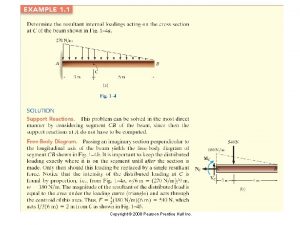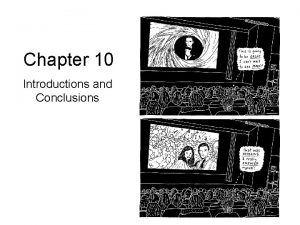CHAPTER FOURTEEN INTEGRATION AND CONCLUSIONS Prentice Hall 2006
















- Slides: 16

CHAPTER FOURTEEN INTEGRATION AND CONCLUSIONS © Prentice Hall 2006 14 -1

Learning Objectives After reading this chapter, you should be able to do the following: ¡ Summarize the general effects of leader behaviors on follower reactions and outcomes. ¡ Identify leader behaviors that most consistently increase quantity or quality of performance by individuals and groups. ¡ Describe the leadership styles that result from various combinations of leader behaviors. ¡ Identify the combinations of leader characteristics and skills that complement the different leadership styles. © Prentice Hall 2006 14 -2

Learning Objectives After reading this chapter, you should be able to do the following: ¡ Identify follower and situational characteristics that impact the effectiveness of different leadership styles. ¡ Describe two general strategies leaders can use to influence the attitudes and performance of individuals and groups. ¡ Describe several dimensions of culture that are important for leaders to consider when working in different regions of the world. ¡ Explain the concept of equifinality in leadership and how it can be applied to increase leadership effectiveness. © Prentice Hall 2006 14 -3

General Effects of Leader Behaviors on Followers (a) LEADER BEHAVIORS Quantity or quality of Individual/Group Performance Individual Role Clarity or Development Supervisor Ratings of Individual/Group Performance DIRECTIVE (b) POSITIVE STRONGLY POSITIVE SUPPORTIVE (b) POSITIVE PARTICIPATIVE SMALL POSITIVE PROBABLY POSITIVE CONTINGENT REWARD POSITIVE CONTINGENT PUNISHMENT PROBABLY POSITIVE (c) ? ? CHARISMATIC PROBABLY POSITIVE STRONGLY POSITIVE ? BUILDING SOCIAL EXCHANGES ? STRONGLY POSITIVE PROBABLY POSITIVE BOUNDARY SPANNING PROBABLY POSITIVE ? FOLLOWERSHIP PROBABLY POSITIVE ? See next slide for footnotes © Prentice Hall 2006 14 -4

General Effects of Leader Behaviors on Followers (cont. ) a—A positive effect means a leader’s behavior results in an increase in followers’ performance, attitudes, role clarity, or group cohesion. A strongly positive effect means the leader behavior results in a large improvement in these follower outcomes. Probably positive means that the results are not certain, but indications point to a positive effect. A negative effect means a leader’s behavior resulted in a decrease in followers’ burnout, turnover, or intent to quit. ? —means research result are either contradictory or there are too few studies to draw a conclusion. b—Positive effects of directive and supportive leadership were often found when both leader behaviors were provided together by the leader. c—When used in conjunction with contingent reward behavior. © Prentice Hall 2006 14 -5

General Effects of Leader Behaviors on Followers (cont. ) LEADER BEHAVIORS Individual Satisfaction, Commitment, or Motivation Individual Turnover, Burnout, or Intent to Quit Group Cohesion DIRECTIVE STRONGLY POSITIVE NEGATIVE SUPPORTIVE STRONGLY POSITIVE NEGATIVE PARTICIPATIVE POSITIVE PROBABLY NEGATIVE CONTINGENT POSITIVE REWARD PROBABLY POSITIVE ? CONTINGENT PUNISHMENT ? ? ? CHARISMATIC STRONGLY POSITIVE(d) ? NEGATIVE BUILDING SOCIAL EXCHANGES STRONGLY POSITIVE ? ? BOUNDARY PROBABLY POSITIVE SPANNING ? PROBABLY NEGATIVE FOLLOWERSHIP PROBABLY POSITIVE ? PROBABLY POSITIVE d—Most followers react very positively to charismatic leadership, although some individuals can react Hall very negatively. © Prentice 2006 14 -6

Applying the Coaching Leadership Style 1. DIAGNOSING THE SITUATION ¿ Are followers “learning the ropes” of the organization? ¿ Are followers still developing their job skills? ¿ Are followers faced with high job stress or insecurity? ¿ Do followers have a high need for clarity and guidance in their work roles? ¿ Does the leader have good interpersonal and communication skills? If “yes” to one or more of these questions, then followers will probably respond favorably to coaching leadership 3. MODIFYING FOLLOWERS AND/OR SITUATIONS 2. PROVIDING A COACHING LEADERSHIP STYLE Leader demonstrates coaching behaviors by: § Explaining what is expected in terms of goals Alleviate stressors, insecurities, and for quantity, quality, and timeliness of conflicts facing followers performance Modify followers’ situations to increase intrinsic satisfaction and task feedback § Outlining useful methods to complete tasks § Increasing the amount of participation as build procedures that allow followers’ development progresses to obtain resources & solve problems on their own § Showing concern and consideration for followers as individuals and expressing Encourage reliance on other followers with high levels of competence and confidence in followers’ potential experience § Showing appreciation for followers’ efforts through compliments and recognition Leaders act to: § § © Prentice Hall 2006 14 -7

Applying the Human Relations Leadership Style 1. DIAGNOSING THE SITUATION ¿Is the organization undergoing a major change such as a merger or downsizing? ¿Has there been some environmental or economic event which has damaged the organization’s or followers’ group? If “yes” to one or both of these questions, followers will probably respond favorably to human relations leadership. 3. MODIFYING FOLLOWERS AND/OR SITUATIONS Leaders act to: § Alleviate uncertainty and ambiguity for followers § Affirm the importance of followers’ roles to the organization § Create policies and procedures to guide followers through organizational changes § Assure followers have the physical and human resources to do their job 2. PROVIDING A HUMAN RELATIONS LEADERSHIP STYLE Leaders demonstrate human relations behaviors by: § Showing concern for followers’ welfare and comfort § Keeping followers informed about important issues § Listening actively to followers’ ideas and concerns § Including followers in decision making and problem solving § Interacting frequently with outsiders to obtain needed information and other resources © Prentice Hall 2006 14 -8

Applying the Controlling Autocratic Leadership Style 1. DIAGNOSING THE SITUATION ¿ Are followers facing a situation which is an immediate threat to their welfare? ¿ Are followers facing an emergency requiring quick action? ¿ Do followers’ clients or customers require immediate action to save them from great loss or damage? If “yes” to one or more of these questions, followers will probably respond favorably to the controlling autocrat in this situation. 3. MODIFYING FOLLOWERS AND/OR SITUATIONS Leaders act to: § Better define procedures to deal with threatening situations § Provide training to prepare followers for emergencies § Improve the group’s ability to predict threats or emergencies before they occur 2. PROVIDING A CONTROLLING AUTOCRATIC LEADERHSHIP STYLE Leader demonstrate autocratic behaviors by: § Giving detailed no-nonsense instructions regarding work methods § Clearly stating quantity and quality standards for performance § Clarifying rules and regulations for the group § Explaining to followers the consequences of nonperformance § Punishing followers who do not follow instructions, rules or regulations © Prentice Hall 2006 14 -9

Applying the Transformational Visionary Leadership Style 1. DIAGNOSING THE SITUATION ¿ Are followers extremely frustrated or unhappy with their current situation? ¿ Are followers highly stressed due to strong competition, government action or economic developments? ¿ Are followers’ welfare endangered due to technological, political or other environmental changes? ¿ Are followers psychologically weakened due to discrimination, economic hardship or other personal factors? If “yes” to one or more of these questions, followers will probably respond favorably to the transformational visionary style of leadership. 3. MODIFYING FOLLOWERS AND SITUATIONS 2. PROVIDING A TRANSFORMATIONAL VISIONARY LEADERSHIP STYLE Leaders act to: § Decrease stress in followers’ environment § Provide education and training to develop followers’ abilities to respond to change § Provide counseling services to help followers with personal problems § Develop plans and procedures for responding to changes that may affect the followers’ group Leaders demonstrate transformational behaviors by: § Giving inspirational speeches that describe the current situation as intolerable § Outlining a mission and favorable vision of the future § Demonstrating self-confidence & confidence in followers to carry out the mission § Showing concern & consideration for followers and encouraging their development § Representing followers to outsiders to gain resources, cooperation, and support © Prentice Hall 2006 14 -10

Applying the Transactional Exchange Leadership Style 1. DIAGNOSING THE SITUATION ¿ Do followers view their role primarily as trading their time for tangible rewards? ¿ Are followers seriously considering other positions outside the group? ¿ Does the leader have significant resources available to reward followers? ¿ Do followers’ job tasks involve work methods that are clearly learnable and require little inventiveness and creativity? If “yes” to one or more of these questions, followers will probably respond favorably to the transactional exchange style of leadership. 3. MODIFYING FOLLOWERS AND/OR SITUATIONS Leaders act to: § Create programs that increase followers’ commitment to the organization § Create organization-wide reward systems that operate independently of the leader § Create procedures that invite follower participation in creatively solving organizational problems 2. PROVIDING A TRANSACTIONAL EXCHANGE LEADERSHIP STYLE Leader demonstrates transactional behaviors by: § Defining what is expected of followers § Clarifying procedures and work methods § Rewarding, complimenting, and recognizing followers § Letting followers know when they have not performed well § Reprimanding followers for repeated rule violations and low effort § Building close social exchanges with followers the leader believes have high potential © Prentice Hall 2006 14 -11

Applying the Servant Leadership Style 1. DIAGNOSING THE SITUATION ¿ Are followers disillusioned by past leaders or circumstances and in need of a leader they can trust? ¿ Are followers engaged in a long and difficult or discouraging task? ¿ Do followers need confidence and encouragement to engage their hearts in their work? If “yes” to one or more of these questions, followers will probably respond favorably to servant leadership. 3. MODIFYING FOLLOWERS AND/OR SITUATIONS Leaders act to: § Create success experiences for followers to build their confidence § Provide an environment that encourages continued education, training, and development § Encourage group norms for ethical behavior and supportiveness among followers § Make tasks less discouraging by assuring that needed resources are readily available. 2. PROVIDING A SERVANT LEADERSHIP STYLE Leader demonstrates servant leadership by: § Seeing that followers’ needs are met whenever possible § Encouraging followers to develop their potential through education, training, and tackling challenging tasks § Listening carefully to followers’ problems and frustrations § Sharing their own difficulties and limitations with followers § Engaging followers in problem solving and decision making § Communicating a vision and a moral mission for followers § Emphasizing ethical behavior at all times © Prentice Hall 2006 14 -12

Creating Leadership Enhancers and Substitutes Leaders have two general strategies of influence on followers ¡ Use leader behaviors which have direct effects on followers' reactions and behaviors. ¡ Modify or develop organizational programs and environmental factors that guide and shape followers' behavior and performance. © Prentice Hall 2006 14 -13

Globalization and Cross-Cultural Leadership Leaders must adapt their leadership behavior to the national culture and societal institutions where they are situated Nine cultural dimensions for effective leadership • power distance • uncertainty avoidance • humane orientation • institutional collectivism • in-group collectivism that are most important • assertiveness • gender egalitarianism • future orientation • performance orientation © Prentice Hall 2006 14 -14

Preliminary findings of cross-cultural studies ¡ ¡ ¡ Supportiveness improves followers’ attitudes in nearly every country studied Directive leadership may be especially effective in the Middle-East Contingent reward behavior has resulted in high levels of followers’ satisfaction and commitment in many different cultures Contingent punishment behavior may be most impactful in highly individualistic cultures like the U. S. Participative leadership is most effective in cultures that are moderate or low in power distance and uncertainty avoidance Charismatic/transformational leadership may be effective in virtually all cultures © Prentice Hall 2006 14 -15

Equifinality in Leadership The systems concept of equifinality refers to the fact that a final goal can be achieved from many starting points and via numerous means. © Prentice Hall 2006 14 -16
 2008 pearson prentice hall inc
2008 pearson prentice hall inc 2008 pearson prentice hall inc
2008 pearson prentice hall inc 2008 pearson prentice hall inc
2008 pearson prentice hall inc 2005 pearson prentice hall inc
2005 pearson prentice hall inc Pearson prentice hall
Pearson prentice hall Prentice hall inc
Prentice hall inc Prentice hall careers
Prentice hall careers Prentice hall america pathways to the present
Prentice hall america pathways to the present Pearson education 2011
Pearson education 2011 Prentice hall business publishing
Prentice hall business publishing Prentice hall african american history
Prentice hall african american history Prentice hall physical science concepts in action
Prentice hall physical science concepts in action Pearson education inc publishing as pearson prentice hall
Pearson education inc publishing as pearson prentice hall Ocean fisheries
Ocean fisheries Pearson prentice hall
Pearson prentice hall 2005 pearson prentice hall inc
2005 pearson prentice hall inc Pearson education inc publishing as pearson prentice hall
Pearson education inc publishing as pearson prentice hall































